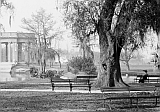|
New Orleans City Park (Images of America) |
|
|
|
~Expansion and Modernization: 1908-1928~ |
||

|
In 1912 the Saux Building was bought in a sheriff's sale by the New Orleans Brewing Company (makers of Double Eagle
and 4XXXX beer) which leased it to Frank LaMothe (former proprietor of LaMothe's Restaurant and Oyster Saloon at 137 St. Charles
Street which claimed to be New Orleans' oldest restaurant). He renamed his new place LaMothe’s
City Park Restaurant and advertised a "fine banquet hall and accommodations for ladies" in local directories
and in City Park festival programs. Men were entertained there by “ladies” from Storyville who relaxed on the
balcony during free time. In 1922 the brewery sold the building to Anthony Compagno whose sons operated it as “Holland
House” offering dining upstairs, ice cream on the first floor, and a barroom in rear. The backroom was purportedly used
by a bookie who exchanged bootlegged rye and scotch for rent. The building later housed Elkin's Coffeehouse. When asked
about the danger of flying John Moisant responded, "I do not expect to die in an airplane" but he did after taking
off from City Park in 1910. A decade later American Magazine of Art, while glowingly praising the Delgado Museum
in 1921, described its visitors as “A quiet and well-behaved company, including a number of Jews, a few Creoles, and
almost no negroes”. A park Aesthetic Committee was formed in 1922 whose members Richard Koch (architect), Julius Dreyfous
(engineer), and Marcel Garsaud created a long range plan. In 1926 the city paid $1,750 for an additional 11 swampy acres between
the park and the lake. In 1927 a 900 acre extension was acquired and in 1928 the first tennis courts were built. : :
|
|
|
The images in this book appear courtesy of the New Orleans Public Library (NOPL), Louisiana Digital Library (LDL), the Library of Congress (LOC), The Historic New Orleans Collection (HNOC), Pictometry International (PI), and D.C. "Infrogmation" May (DCM). Unless otherwise noted, images are from the author's collection.
|
||